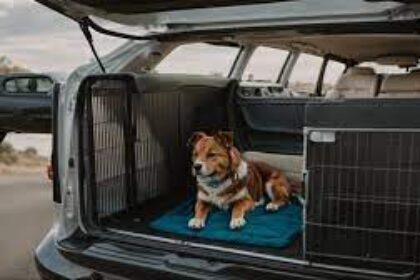
Traveling with Pets: How to Prepare for a Stress-Free Journey

Traveling with pets can be a wonderful experience, but it can also be quite stressful if you’re not properly prepared. Whether you’re taking a road trip, flying to a new destination, or simply heading to the vet, there are several steps you can take to ensure that your furry friend stays safe and comfortable throughout the journey. In this blog post, we will provide you with some tips and tricks on how to prepare for a stress-free journey when traveling with your pets.
Plan Ahead: One of the most important things you can do when traveling with pets is to plan ahead. Make sure you have all the necessary supplies such as food, water, medications, and any other essentials your pet may need. Research pet-friendly accommodations and transportation options in advance to avoid any last-minute surprises.
Visit the Vet: Before embarking on your journey, it’s essential to visit the vet for a check-up. Ensure that your pet is up-to-date on vaccinations and has any necessary paperwork or identification tags. Your vet can also provide you with tips on how to keep your pet calm during travel and may even prescribe medication if needed.
Pack Comfort Items: Just like humans, pets can feel stressed during travel. To help keep them calm and comfortable, pack their favorite toys, blankets, or bedding so they have something familiar to them. Consider bringing along some treats or chews to help distract them during long journeys.
Secure Your Pet: Safety should always be a top priority when traveling with pets. Make sure your pet is properly secured in a carrier or harness while in transit to prevent them from escaping or getting injured in case of sudden stops or accidents. If traveling by car, never let your pet roam freely inside the vehicle.
Take Breaks: If you’re taking a long road trip, remember to take regular breaks to allow your pet to stretch their legs and relieve themselves. Stop at designated rest areas where pets are allowed so they can get some fresh air and exercise before continuing on with the journey.
Traveling with pets doesn’t have to be stressful if you take the time to prepare properly beforehand. By planning ahead, visiting the vet, packing comfort items, securing your pet safely, and taking regular breaks during long journeys, you can ensure that both you and your furry friend have a stress-free travel experience. Remember that every pet is different, so pay attention to their behavior and adjust accordingly to make their journey as comfortable as possible. With these tips in mind, you’ll be well-equipped for an enjoyable adventure with your four-legged companion!
Traveling with Pets: How to Prepare for a Stress-Free Journey
Traveling with your pet can be an exciting adventure, but it also requires careful planning to ensure a safe and stress-free journey. Whether you’re going on a road trip, flying to a new destination, or even just visiting the vet, proper preparation is key to making the experience enjoyable for both you and your furry friend. Here’s how to prepare for a smooth trip with your pet.
1. Visit the Veterinarian
Why It’s Important:
Before any trip, especially if it involves long distances or crossing borders, schedule a check-up with your veterinarian. This ensures your pet is healthy enough to travel and up-to-date on vaccinations.
What to Do:
- Health Certificate: If required, obtain a health certificate from your vet. This is especially important for air travel and international trips.
- Vaccinations and Medications: Ensure your pet’s vaccinations are current, and ask your vet about any medications or treatments needed for the journey (e.g., motion sickness meds or flea preventatives).
- Microchip and ID Tags: Make sure your pet’s microchip information is up to date, and that they are wearing a collar with an ID tag that includes your current contact information.
Tip:
If your pet has any chronic health issues or special needs, discuss these with your vet to get personalized advice for the trip.
2. Choose the Right Carrier or Crate
Why It’s Important:
A sturdy, well-ventilated carrier or crate provides your pet with a safe and comfortable space during travel. It also helps minimize stress by giving them a familiar environment.
What to Do:
- Size Matters: Ensure the carrier or crate is large enough for your pet to stand, turn around, and lie down comfortably.
- Comfort: Line the carrier with a soft blanket or towel that smells like home to provide comfort.
- Ventilation: Make sure the carrier has plenty of ventilation and is secure enough to prevent your pet from escaping.
Tip:
Familiarize your pet with the carrier or crate before the trip by allowing them to explore it at home. This helps reduce anxiety on travel day.
3. Pack the Essentials
Why It’s Important:
Having all the necessary supplies on hand makes the journey smoother and ensures your pet’s needs are met throughout the trip.
What to Pack:
- Food and Water: Bring enough of your pet’s regular food and a supply of fresh water for the entire trip. Don’t forget portable bowls!
- Leash and Harness: Always have a sturdy leash and harness handy, especially for bathroom breaks or walking in unfamiliar areas.
- Toys and Comfort Items: Pack a few of your pet’s favorite toys and a familiar blanket to keep them entertained and comfortable.
- Waste Bags and Litter: For dogs, bring waste bags for clean-up. For cats, bring a portable litter box and litter.
- First Aid Kit: Include a basic first aid kit with bandages, antiseptic, and any medications your pet may need.
Tip:
If your pet has a special diet or requires prescription food, pack extra in case of travel delays.
4. Plan for Pit Stops and Breaks
Why It’s Important:
Regular breaks allow your pet to stretch, relieve themselves, and get some fresh air, which helps reduce stress and discomfort during the journey.
What to Do:
- Schedule Breaks: Plan to stop every 2-3 hours during road trips to let your pet out for a bathroom break and a short walk.
- Safe Areas: Choose rest stops or parks where your pet can safely get out of the car and walk around.
- Water Breaks: Offer water at each stop to keep your pet hydrated, especially in warm weather.
Tip:
Never leave your pet alone in a parked car, as temperatures can quickly become dangerous, even with the windows cracked.
5. Know the Rules and Regulations
Why It’s Important:
Different modes of travel and destinations have varying rules for traveling with pets. Knowing these in advance helps avoid any surprises or delays.
What to Check:
- Airline Policies: If flying, check the airline’s pet policy, including carrier requirements, fees, and restrictions on breeds or sizes.
- Hotel Pet Policies: Confirm that your accommodations are pet-friendly and understand any rules they may have regarding pets.
- Travel Documentation: For international travel, check the destination’s entry requirements for pets, including quarantine rules, vaccinations, and documentation.
Tip:
Always keep a copy of your pet’s vaccination records and any required documentation in an easily accessible place during the trip.
6. Prepare for Air Travel
Why It’s Important:
Air travel can be particularly stressful for pets, so extra preparation is needed to ensure their comfort and safety.
What to Do:
- Book Early: Reserve your pet’s spot in the cabin or cargo hold as soon as possible, as airlines often have limited space for pets.
- Check Temperature Restrictions: Some airlines have temperature restrictions for pets traveling in the cargo hold, so check this in advance, especially during summer and winter.
- Acclimate Your Pet: If your pet will be traveling in the cargo hold, help them get used to the crate by practicing at home with short periods inside.
Tip:
Consider booking a direct flight to minimize travel time and the stress of layovers or plane changes.
7. Prepare Your Pet for the Journey
Why It’s Important:
Helping your pet adjust to the idea of travel before the trip can reduce anxiety and make the experience more enjoyable for both of you.
What to Do:
- Practice Short Trips: Take your pet on short car rides to help them get used to being in a moving vehicle.
- Crate Training: If your pet isn’t already crate-trained, start the process well in advance of the trip.
- Desensitize to Travel Sounds: Play travel-related sounds, like car engines or airport noises, at home to help desensitize your pet.
Tip:
For particularly anxious pets, consult your veterinarian about calming products or medications that can help make travel easier.
8. Prepare for the Destination
Why It’s Important:
Arriving at your destination with a plan ensures your pet’s needs are met from the moment you arrive.
What to Do:
- Set Up a Comfortable Space: As soon as you arrive, set up a comfortable area for your pet with their bed, toys, and water.
- Explore the Area: Take your pet for a walk around the area to help them get accustomed to their new surroundings.
- Stick to Routine: Try to maintain your pet’s regular feeding and exercise schedule to provide a sense of normalcy.
Tip:
Bring along familiar items from home, like your pet’s bed or favorite toys, to help them feel more secure in the new environment.
Conclusion
Traveling with your pet can be a wonderful experience with the right preparation. By planning ahead, packing the essentials, and making your pet’s comfort and safety a priority, you can ensure a stress-free journey for both of you. Whether you’re taking a short trip or a long adventure, these tips will help make your travels together smooth and enjoyable. Happy travels with your furry friend! 🐾✈️


